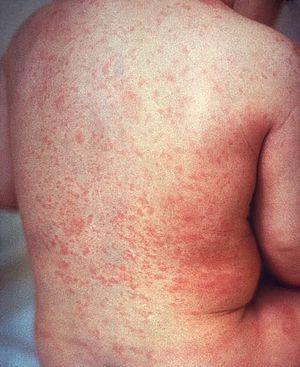German measles
| Rubella | |
|---|---|
| Synonyms | German measles, three-day-measles |
 |
|
| A rash due to rubella on a child's back. The area affected is similar to that of measles but the rash is less intensely red. | |
| Specialty | Infectious disease |
| Symptoms | Rash, swollen lymph nodes, fever, sore throat, feeling tired |
| Complications | Testicular swelling, inflammation of nerves, congenital rubella syndrome, miscarriage |
| Usual onset | 2 weeks after exposure |
| Duration | 3 days |
| Causes | Rubella virus (spread through the air) |
| Diagnostic method | Finding the virus in the blood, throat, or urine, antibody tests |
| Prevention | Rubella vaccine |
| Treatment | Supportive care |
| Frequency | Common in many areas |
| Classification | |
|---|---|
| External resources |
Rubella, also known as German measles or three-day measles, is an infection caused by the rubella virus. This disease is often mild with half of people not realizing that they are sick. A rash may start around two weeks after exposure and last for three days. It usually starts on the face and spreads to the rest of the body. The rash is not as bright as that of measles and is sometimes itchy. Swollen lymph nodes are common and may last a few weeks. A fever, sore throat, and fatigue may also occur. In adults joint pain is common. Complications may include bleeding problems, testicular swelling, and inflammation of nerves. Infection during early pregnancy may result in a child born with congenital rubella syndrome (CRS) or miscarriage. Symptoms of CRS include problems with the eyes such as cataracts, ears such as deafness, heart, and brain. Problems are rare after the 20th week of pregnancy.
Rubella is usually spread through the air via coughs of people who are infected. People are infectious during the week before and after the appearance of the rash. Babies with CRS may spread the virus for more than a year. Only humans are infected. Insects do not spread the disease. Once recovered, people are immune to future infections. Testing is available that can verify immunity. Diagnosis is confirmed by finding the virus in the blood, throat, or urine. Testing the blood for antibodies may also be useful.
Rubella is preventable with the rubella vaccine with a single dose being more than 95% effective. Often it is given in combination with the measles vaccine and mumps vaccine, known as the MMR vaccine. With a population vaccination rate of less than 80%, however, more women might make it to childbearing age without developing immunity and issues could increase. Once infected there is no specific treatment.
...
Wikipedia
